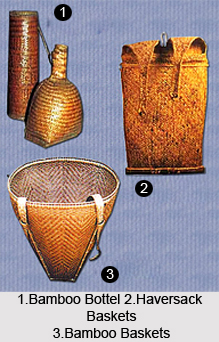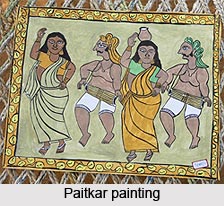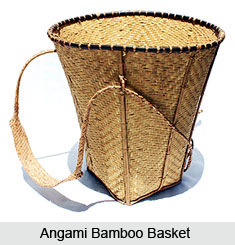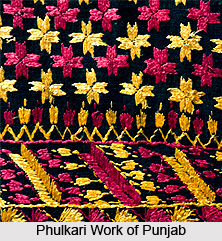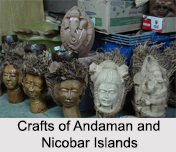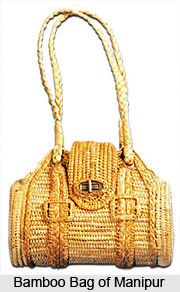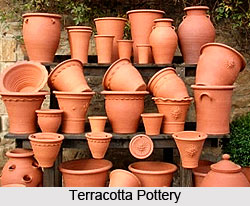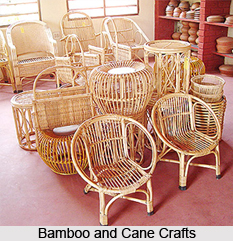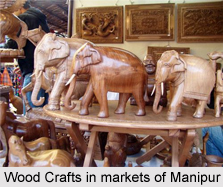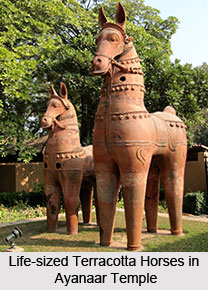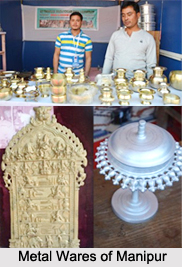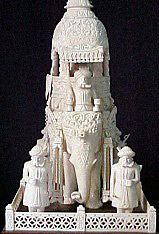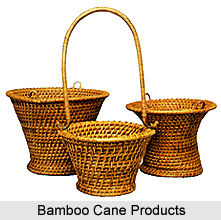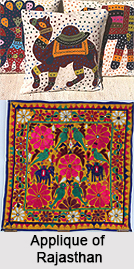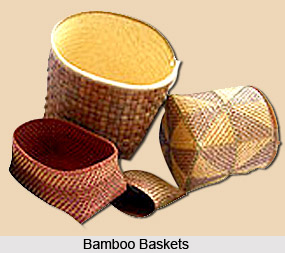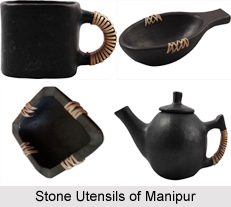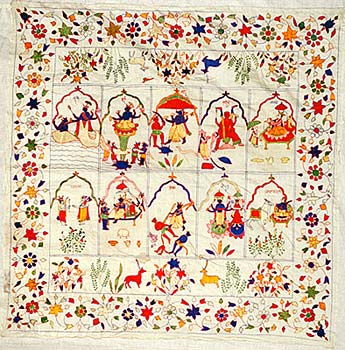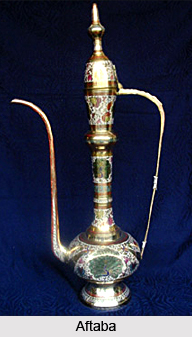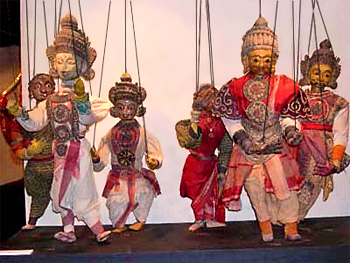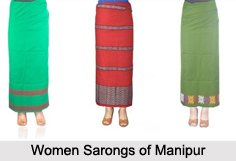 The tribes of Manipur mainly inhabit the hills of the state. Their textiles are all produced on the Loins loom or Indonesian tension loom. The fabrics are fairly thick as the warp is dense and covers the weft, giving them a ribbed effect. Only fabrics of smaller width (between 51 and 62 centimetres) can be woven and most of the textiles are made of several strips stitched together. Fabrics woven on Loins loom are predominated warp faced. As a result, when different coloured yarns are added into the warp, the strips become bold and achieve full strength of the colours. Women wear a Sarong, which is a fabric 77 to 92 centimetres wide and 180 to 205 centimetres long. This is worn wrapped around the lower part of the body, and is mostly put on with a blouse. The women use a similar fabric shorter in length called a shawl. In the hilly places among the inhabitants, the shawl and Sarong fabric designs are the definite indication of the tribe to which they belong.
The tribes of Manipur mainly inhabit the hills of the state. Their textiles are all produced on the Loins loom or Indonesian tension loom. The fabrics are fairly thick as the warp is dense and covers the weft, giving them a ribbed effect. Only fabrics of smaller width (between 51 and 62 centimetres) can be woven and most of the textiles are made of several strips stitched together. Fabrics woven on Loins loom are predominated warp faced. As a result, when different coloured yarns are added into the warp, the strips become bold and achieve full strength of the colours. Women wear a Sarong, which is a fabric 77 to 92 centimetres wide and 180 to 205 centimetres long. This is worn wrapped around the lower part of the body, and is mostly put on with a blouse. The women use a similar fabric shorter in length called a shawl. In the hilly places among the inhabitants, the shawl and Sarong fabric designs are the definite indication of the tribe to which they belong.
Textiles of Naga Tribes of Manipur
The Naga tribes of Manipur have similar textile technology and culture to the Naga tribes of Nagaland, though there are differences in design. One of the well known Naga tribes of Manipur is Rongmei Naga, often referred to as Kabui. They have similarity with the Zeme and Liamgmei Nagas of Assam and Nagaland, together known as the Zeliangrong Nagas. Like any other Naga tribe, the Rongmeis also used to grow short staple cotton, spinning them with drop spindle or spinning wheel and weaving fabrics with Loins loom. However, their ginning method is rather better than their cousins, which they have supposedly learnt from the Mizos and the Kukis. They also used nettle fibre as raw material for their textile products. Their traditional costumes were simple yet beautiful, which however have undergone considerable changes as they also switched over to mill made yarns as their cousins.
Amongst the other Naga tribes are the Maram Nagas, living close to the Manipur-Nagaland border almost on the Imphal-Kohima national highway. They are considered one of the quasi-Angami tribes, owing to their similarity with the Angami Nagas that also encompasses the textile technology adopted by them. The ordinary dress of a Maram Naga consists of a short black cotton kilt ornamented by three or four rows of white cowries, or in these days white trouser buttons. A white cotton rug thrown over the shoulders completes the costume. The Mao Nagas are another quasi-Angami tribe who only inhabit the boundary of Nagaland and Manipur, again obviously bringing considerable influence of the Angami styles and designs. They are further subdivided into various sub-tribes like Merni and Paomata, who also maintain their separate identity though the textiles and dresses are more or less identical. Their ordinary costume is again the same as the Maram Nagas.
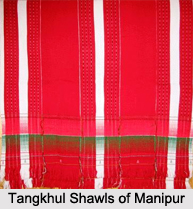 The Tangkhul Naga tribe found settled in the Ukhrul district of Manipur are considered to be one of the exceptional tribes among the Nagas in many ways. It is the only tribe having features of both Mongoloid and Aryans, which makes them one of the most handsome people of the east. Traditionally, the Tangkhuls are divided into eight regional divisions: North Raphei, Northeast - Somra, Southeast - Kaikhang, East - Ram, South - Kamao, West - Kharao, Southwest - Kharei and Northwest - Kharas Raora. People of each division are supposedly experts in a particular skill, product of which is consumed by the entire tribe. The Kharaos are the expert weavers and even today they produce the bulk of cloth used by the Tangkhuls. They use the technology almost identical to all the other Naga tribes, which has also undergone identical changes. Their designs of fabrics whether shawls, wrappers or petticoats, are exquisite. Dull or bright red shawls embroidered with white threads are one of the popular Tangkhul shawls of Manipur.
The Tangkhul Naga tribe found settled in the Ukhrul district of Manipur are considered to be one of the exceptional tribes among the Nagas in many ways. It is the only tribe having features of both Mongoloid and Aryans, which makes them one of the most handsome people of the east. Traditionally, the Tangkhuls are divided into eight regional divisions: North Raphei, Northeast - Somra, Southeast - Kaikhang, East - Ram, South - Kamao, West - Kharao, Southwest - Kharei and Northwest - Kharas Raora. People of each division are supposedly experts in a particular skill, product of which is consumed by the entire tribe. The Kharaos are the expert weavers and even today they produce the bulk of cloth used by the Tangkhuls. They use the technology almost identical to all the other Naga tribes, which has also undergone identical changes. Their designs of fabrics whether shawls, wrappers or petticoats, are exquisite. Dull or bright red shawls embroidered with white threads are one of the popular Tangkhul shawls of Manipur.
Textiles of Kuki Tribes of Manipur
The Koren or Quoireng tribe is one of the old Kuki tribes living close a few other such tribes and the Maram Nagas. Textile technology is identical to both, with influence of the designs of Angamis, old Kukis and Meitheis on their designs. Men wear the short black kilt in the custom of their neighbours, the Angamis with whom they share trade relations. Women petticoats are of various kinds, a popular one being striped like the Meithei Phanek, but border embroidery being akin to the Kuki designs. They are all woven at home.
The Anal tribe, found settled in the south-eastern part of Manipur, are also part of the old Kukis, though they consider themselves as one of the Naga tribes. Along with the Moyons, Monsangs, Koms etc., they call themselves as the Pakan tribe. Culturally and linguistically, they are close to Lushei-Kuki-Chin group of tribes though the influence of Naga culture cannot be ruled out completely. Due to long subjugation, there is also influence of the Meithei culture. The folk stories related to their origin are identical to those of the Mizos and the Kukis. Their textile technology is basically similar to those of the Nagas, Kukis and Mizos who used to spin yarn from locally grown short staple cotton with drop spindle or spinning wheel, dye the yarn with locally available vegetable dyes and weave fabrics with the Loins loom. Like their cousins, their designs have undergone identical changes, discarding the traditional spinning and dyeing technology but continuing with same old weaving technology using coloured mill yarns.
The new Kuki group of tribes, such as Thadou, Gangte, Paite, Poi, Lushei and other Mizo tribes, are comparatively recent migrants to Manipur who are found settled mostly around Churachandpur and a few select hamlets almost all over Manipur. Out of all these tribes, Thadou is demographically the biggest and their textile technology is identical to those of Nagas and other Indo-Mongoloid tribes of the region. They used to grow cotton of short staple length in their fields, sundry them after harvesting, gin them either by hand picking or by simple hand operated gins, convert them into sliver by rolling over a thin stick of grass, spin into yarn with the help of drop spindle or spinning wheel, dye the yarn with vegetable dye and finally weave beautiful fabrics with the help of the back strap Loins loom. The changes that have taken place in the past few decades are also identical, with cessation of almost all preliminary operations, preserving only weaving which is done with mill yarn of various colours with the help of Loins loom. The embroidered designs on the fabrics of Thadous, Gangtes, Mizos including Lusheis and other Kuki group of tribes are one of the most beautiful and rarely seen art works. The design and colour matching of the fabrics of these groups of new Kukis are found to be more attractive than that of their cousins, the Nagas and the old Kukis. The fabrics produced by the Mizos are called Puans, the different designs of which are more or less identical amongst almost all Mizo-Kuki groups, with minor local variations. The development of technology and design among the Mizo Kukis are gradual, thus a great lot of variation has been noticed.
Related Articles:
Textiles of Manipur
Crafts of Manipur
Tribes of Manipur
Indian Costumes
Weaving and Dyeing Craft
Silk
Cotton Fabrics
Naga Tribes
Nagaland
Mizos
